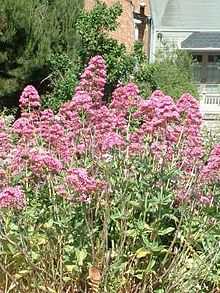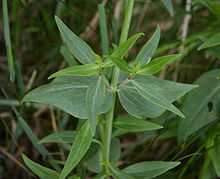Centranthus ruber
| Centranthus ruber | |
|---|---|
 | |
| Scientific classification | |
| Kingdom: | Plantae |
| (unranked): | Angiosperms |
| (unranked): | Eudicots |
| (unranked): | Asterids |
| Order: | Dipsacales |
| Family: | Valerianaceae |
| Genus: | Centranthus |
| Species: | C. ruber |
| Binomial name | |
| Centranthus ruber (L.) DC. | |
Centranthus ruber, also called valerian or red valerian, is a popular garden plant grown for its ornamental flowers. Other common names include Jupiter's beard and spur valerian.
Description

It grows as a perennial plant, usually as a subshrub though it can take any form from a herb to a shrub depending on conditions; the plants are usually woody at the base. The leaves are generally 5–8 cm in length. Their form changes from the bottom to the top of the plant, the lower leaves being petioled while the upper leaves are sessile. The leaves grow in opposite pairs and are oval or lanceolate in shape. The plant flowers profusely, and though the individual flowers are small (no more than 2 cm), the inflorescences are large and showy. The flowers are small in rounded clusters each with 5 fused petals and a spur. They are purplish red and sometimes (about 10% of individuals) white and occasionally lavender in color. Flowering takes place in early summer. They have a strong and somewhat rank scent. They are pollinated by both bees and butterflies and the plant is noted for attracting insects. It is used as a food plant by the larvae of some Lepidoptera species including Angle Shades. Seeds have tufts similar to dandelions that allow wind dispersal, and as such can become self-seed and become invasive if not properly controlled.
Distribution
A native of the Mediterranean region, Centranthus ruber has been introduced into many other parts of the world as a garden escape. It is naturalised in Australia, Great Britain and the United States. In the US it can be found growing wild in such western states as Arizona, Utah, California, Hawaii, and Oregon, usually in disturbed, rocky places at elevations below 200 m. It is often seen by roadsides or in urban wasteland. It can tolerate very alkaline soil conditions, and will grow freely in old walls despite the lime in their mortar.
Uses
.jpg)

Both leaves and roots can be eaten, the leaves either fresh in salads or lightly boiled, the roots boiled in soups. Opinions differ as to whether either make very good eating, however. Although it is sometimes reported to have medicinal properties, there is no basis for this view, which is almost certainly due to confusion with true valerian, (Valeriana officinalis).
External links
| Wikimedia Commons has media related to Red Valerian. |
- Jepson Manual species treatment
- USDA Plants Profile
- Entry in the Plants for a Future database
- Images from the CalPhotos archive